|
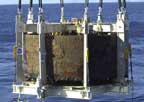
|
The turret of the Civil War ironclad USS Monitor is lifted out of the Atlantic Ocean and onto the work barge Wotan, off the coast of Hatteras N.C., Aug 5, 2002. The silt-packed turret was raised Monday afternoon from the Atlantic floor, nearly 140 years after the historic warship sank during a New Year's storm. (Photo: AP Pool/Steve Helber)
|
|

|
Navy divers celebrate as the turret of the USS Monitor breaks the surface Aug. 5, 2002, off the coast of Hatteras, N.C. (Photo: AP Pool/Steve Early)
|
|
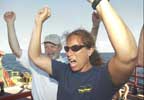
|
Monitor Marine Sanctuary Director John Broadwater, left, and Cmdr. Bobbie Scholley react as the turret of the Civil War ironclad USS Monitor is placed on the deck of awork barge off the coast of Hatteras, N.C., Monday, Aug 5, 2002. (Photo: AP Pool/Steve Helber)
|
|

|
Workers look over the turret of the USS Monitor after it was brought onto the deck of a work barge Aug. 5, 2002, off the coast of Hatteras, N.C. (Photo: AP Pool/Steve Early)
|
|
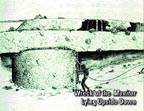
|
The USS Monitor is currently
resting upside-down on its displaced turret. The
turret is at the stern section of the ship. Initial
archaeological dives retrieved items such as china,
armor plates, and the signal lantern.
(illustration: Jeff Johnston)
|
|

|
Sonar image of the Monitor,
obtained on a recent survey by the NOAA Ship
WHITING. (image: US NOAA Corps.)
|
|

|
An illustration of the
Monitor as seen from above it's current position.
(illustration: Jeff Johnston)
|
|

|
The signal lantern used by
the Monitor's crew was found during a dive at the
wreck. (photo: The Mariner's Museum)
|
<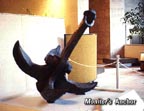
|
The Monitor's anchor was
recovered in 1983 and is now currently on display
at the Mariner's Museum in Newport News, VA. The
three ton iron propeller was recovered in 1998
during a joint mission between the Navy, NOAA and
other research organizations.(photo: The Mariner's
Museum)
|
|


|
The goals of the Summer 2000
expedition are to stabilize the Monitor's hull with
bags filled with grout (concrete) and deploy a 85
ton Engine Recovery Structure. This structure will
be used next summer (2001), when the Navy/NOAA
expedition team will attempt to recover the
Monitor's unique steam engine. (illustrations: Jeff
Johnston)
|
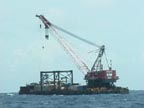
|
The expedition team consists
of Naval and civilian personnel. All will be
stationed aboard the Weeks 526, a 350 ton
capacity American derrick. It will support berthing
and messing for mission personnel, the navy dive
system, two hyper baric chambers, the engine
recovery system (ERS), and the grouting system.
(photo: Monitor NMS)
|
|
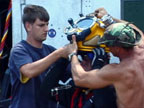
|
Navy divers are utilizing
specialized diving equipment such as the mK-21 MOD
1 Diving Helmet. This helmet is used by the navy
for salvage and deep water diving. Cameras and
lights are mounted on the helmet in order to video
record the salvage effort. The helmet alone weighs
27 lbs. dry. (photo: Monitor NMS)
|
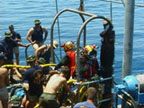
|
Navy divers are lowered over
the side, down to the wreck, on the "stage". These
divers will be walking on the bottom rather than
swimming. Their mission is to stabilize the hull,
record information, and time permitting, retrieve
smaller artifacts from the wreck. (photo: Monitor
NMS)
|
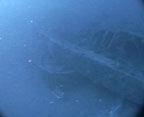
|
A diver's view of the wreck
of the USS Monitor as seen from the "stage".
(photo: Monitor NMS)
|
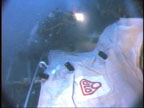
|
Divers are placing grout bags
under the hull of the Monitor in predetermined
stabilization areas. These bags contain the
grout (concrete) so that it may harden in
place. Divers may only stay down for short periods
of time, so they must rotate a number of divers
throughout the day. A decompression chamber is on
board the Weeks 526, which the divers must
use after each dive. (photo: Monitor
NMS)
|
|
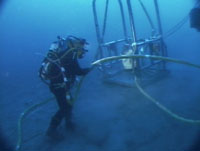
|
Underwater view of diver
returning to the "stage".(photo: Monitor
NMS)
|
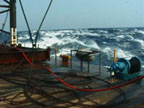
|
Waves as seen from the
Weeks 526. Rough weather and severe currents
have hampered operations, but work progresses.
(photo: Monitor NMS)
|
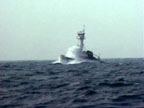
|
A wave jumps over the bow and
onto the pilot house of the Tug Katherine.
The Katherine is stationed with the Weeks
526 for support. (photo:
Monitor NMS)
|
|
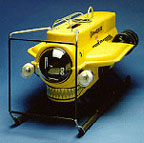
|
The expedition also utilizes
an Remotely Operated Vehicle and a Submersible to
conduct research activities around the wreck of the
USS Monitor. This is the SeaROVER. (photo:
US Navy)
|
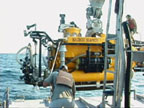
|
The Clelia is a
submersible currently being used to support the
mission. The Clelia is owned and operated by
Harbor Branch Oceanographic Institution (HBOI). In
this photo the Clelia is being lowered over
the side of the HBOI research vessel Sea
Diver (photo: Monitor NMS)
|
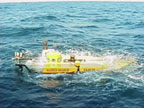
|
Clelia submerging for
a mission.(photo: Monitor NMS)
|
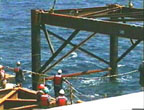
|
The "Bridge", first and
largest of three sections of the Engine Recovery
System, is lowered into the water. It will remain
over the wreck until the engine is recovered. Two
other portions of the ERS, the trolley and the
engine lift frame will also be deployed.(photo:
Monitor NMS)
|
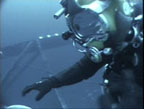
|
A Navy diver assisting in the
underwater portion of the deployment of the
"bridge" section of the ERS. You can see a portion
of the bridge in the background of this photo.
(photo: Monitor NMS)
|
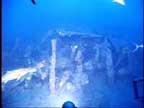
|
This section of the Monitor
was once the Captain's state room. This image was
taken from the submersible Clelia. (photo:
Monitor NMS)
|
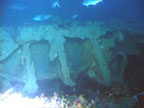
|
View of the Engine Frame.
Photo was taken from the Clelia. (photo: Monitor
NMS)
|
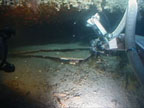
|
The Clelia attempts to
recover armor plates which have fallen from the
wreck. (photo: Monitor NMS)
|





